Forecasting the Future: The Role of Technology in Accounting Systems
VerifiedAdded on 2023/05/26
|10
|2203
|252
Project
AI Summary
This project proposal explores the role of technology in accounting and forecasts its future capabilities. It reviews existing literature, identifies gaps concerning the definitive role of technology and future trends, and sets out research aims and objectives. The study aims to identify technologies that will drive future accounting practices, assess technology's role as an enabler versus a challenge (considering security and fraud), discuss emerging technologies, and determine their feasibility in accounting environments. The project employs a positivism research philosophy with an exploratory design, utilizing secondary data collection methods and thematic analysis. The data sources include statistical data from the Australian Bureau of Statistics and other relevant publications. The project plan includes a timeline with key activities from topic selection to final report submission. Desklib offers students access to similar past papers and solved assignments.
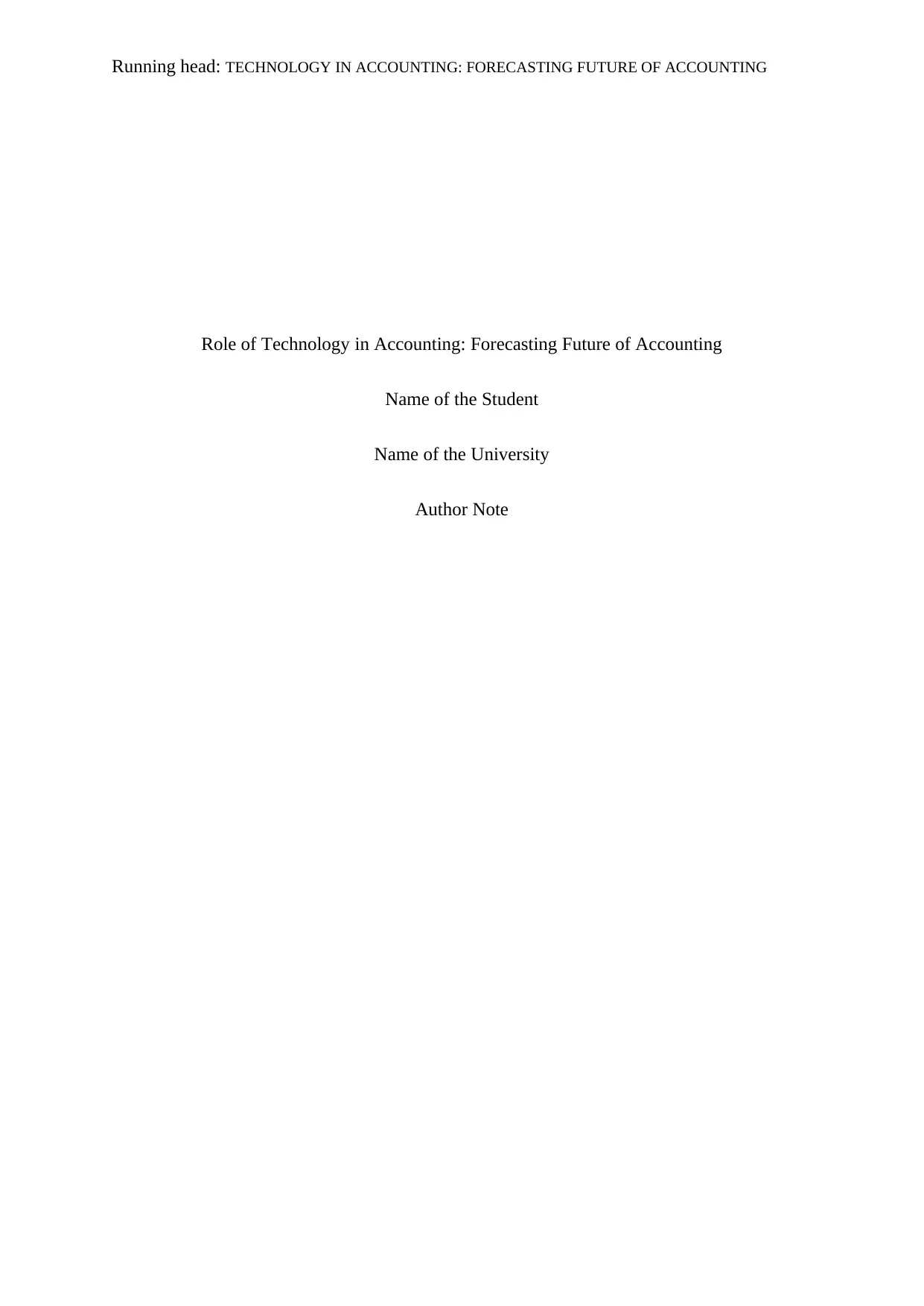
Running head: TECHNOLOGY IN ACCOUNTING: FORECASTING FUTURE OF ACCOUNTING
Role of Technology in Accounting: Forecasting Future of Accounting
Name of the Student
Name of the University
Author Note
Role of Technology in Accounting: Forecasting Future of Accounting
Name of the Student
Name of the University
Author Note
Paraphrase This Document
Need a fresh take? Get an instant paraphrase of this document with our AI Paraphraser
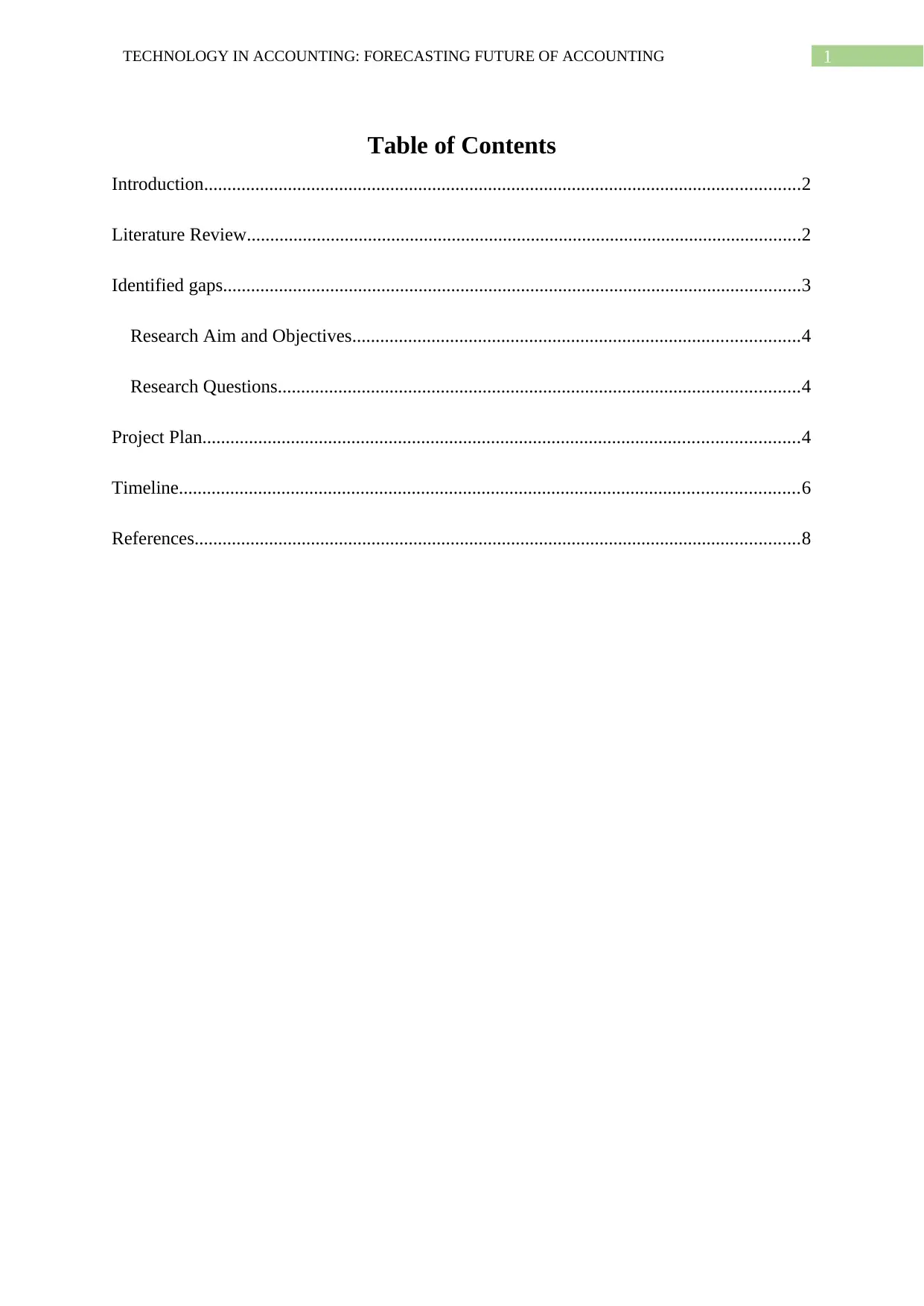
1TECHNOLOGY IN ACCOUNTING: FORECASTING FUTURE OF ACCOUNTING
Table of Contents
Introduction................................................................................................................................2
Literature Review.......................................................................................................................2
Identified gaps............................................................................................................................3
Research Aim and Objectives................................................................................................4
Research Questions................................................................................................................4
Project Plan................................................................................................................................4
Timeline.....................................................................................................................................6
References..................................................................................................................................8
Table of Contents
Introduction................................................................................................................................2
Literature Review.......................................................................................................................2
Identified gaps............................................................................................................................3
Research Aim and Objectives................................................................................................4
Research Questions................................................................................................................4
Project Plan................................................................................................................................4
Timeline.....................................................................................................................................6
References..................................................................................................................................8
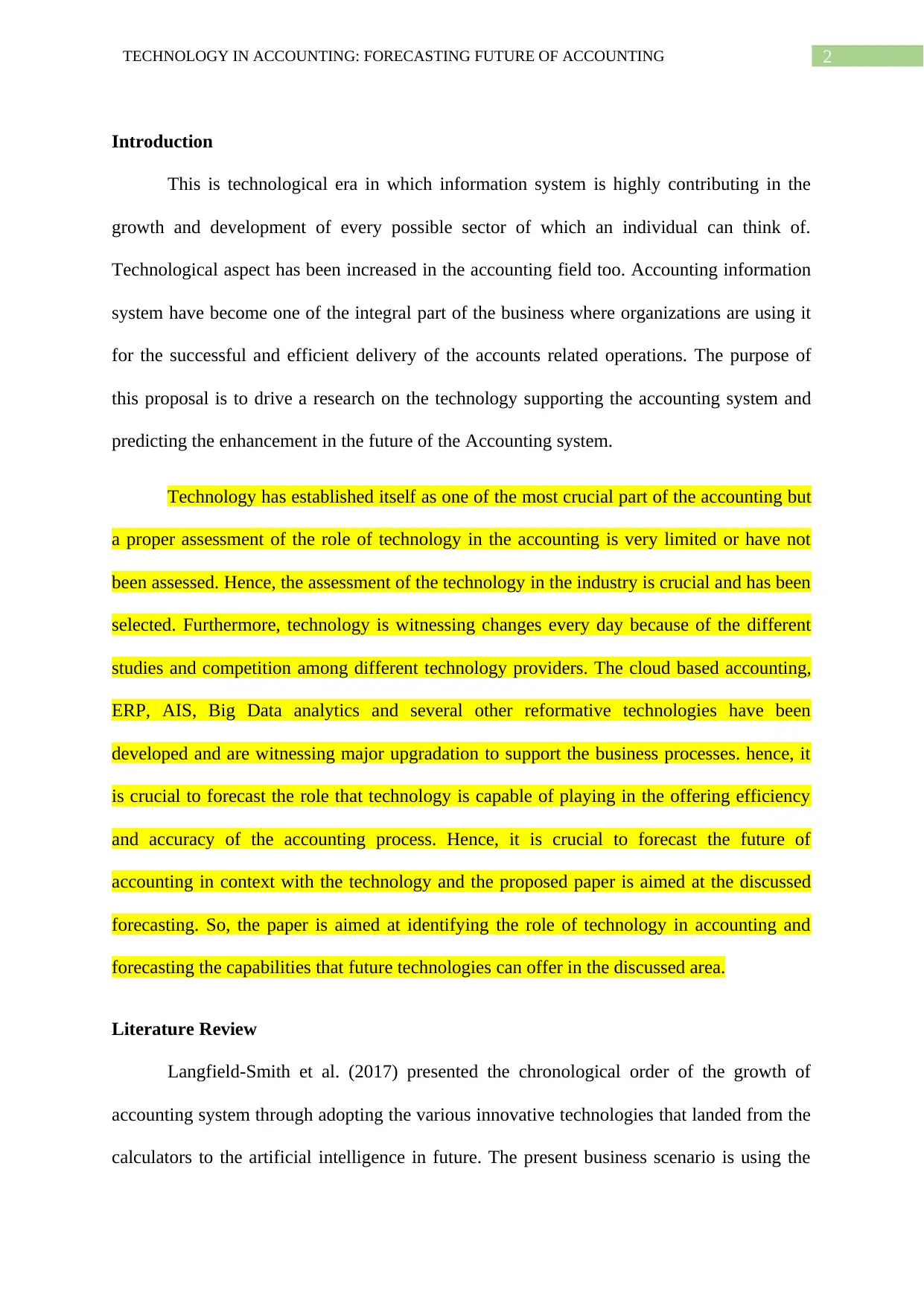
2TECHNOLOGY IN ACCOUNTING: FORECASTING FUTURE OF ACCOUNTING
Introduction
This is technological era in which information system is highly contributing in the
growth and development of every possible sector of which an individual can think of.
Technological aspect has been increased in the accounting field too. Accounting information
system have become one of the integral part of the business where organizations are using it
for the successful and efficient delivery of the accounts related operations. The purpose of
this proposal is to drive a research on the technology supporting the accounting system and
predicting the enhancement in the future of the Accounting system.
Technology has established itself as one of the most crucial part of the accounting but
a proper assessment of the role of technology in the accounting is very limited or have not
been assessed. Hence, the assessment of the technology in the industry is crucial and has been
selected. Furthermore, technology is witnessing changes every day because of the different
studies and competition among different technology providers. The cloud based accounting,
ERP, AIS, Big Data analytics and several other reformative technologies have been
developed and are witnessing major upgradation to support the business processes. hence, it
is crucial to forecast the role that technology is capable of playing in the offering efficiency
and accuracy of the accounting process. Hence, it is crucial to forecast the future of
accounting in context with the technology and the proposed paper is aimed at the discussed
forecasting. So, the paper is aimed at identifying the role of technology in accounting and
forecasting the capabilities that future technologies can offer in the discussed area.
Literature Review
Langfield-Smith et al. (2017) presented the chronological order of the growth of
accounting system through adopting the various innovative technologies that landed from the
calculators to the artificial intelligence in future. The present business scenario is using the
Introduction
This is technological era in which information system is highly contributing in the
growth and development of every possible sector of which an individual can think of.
Technological aspect has been increased in the accounting field too. Accounting information
system have become one of the integral part of the business where organizations are using it
for the successful and efficient delivery of the accounts related operations. The purpose of
this proposal is to drive a research on the technology supporting the accounting system and
predicting the enhancement in the future of the Accounting system.
Technology has established itself as one of the most crucial part of the accounting but
a proper assessment of the role of technology in the accounting is very limited or have not
been assessed. Hence, the assessment of the technology in the industry is crucial and has been
selected. Furthermore, technology is witnessing changes every day because of the different
studies and competition among different technology providers. The cloud based accounting,
ERP, AIS, Big Data analytics and several other reformative technologies have been
developed and are witnessing major upgradation to support the business processes. hence, it
is crucial to forecast the role that technology is capable of playing in the offering efficiency
and accuracy of the accounting process. Hence, it is crucial to forecast the future of
accounting in context with the technology and the proposed paper is aimed at the discussed
forecasting. So, the paper is aimed at identifying the role of technology in accounting and
forecasting the capabilities that future technologies can offer in the discussed area.
Literature Review
Langfield-Smith et al. (2017) presented the chronological order of the growth of
accounting system through adopting the various innovative technologies that landed from the
calculators to the artificial intelligence in future. The present business scenario is using the
⊘ This is a preview!⊘
Do you want full access?
Subscribe today to unlock all pages.

Trusted by 1+ million students worldwide
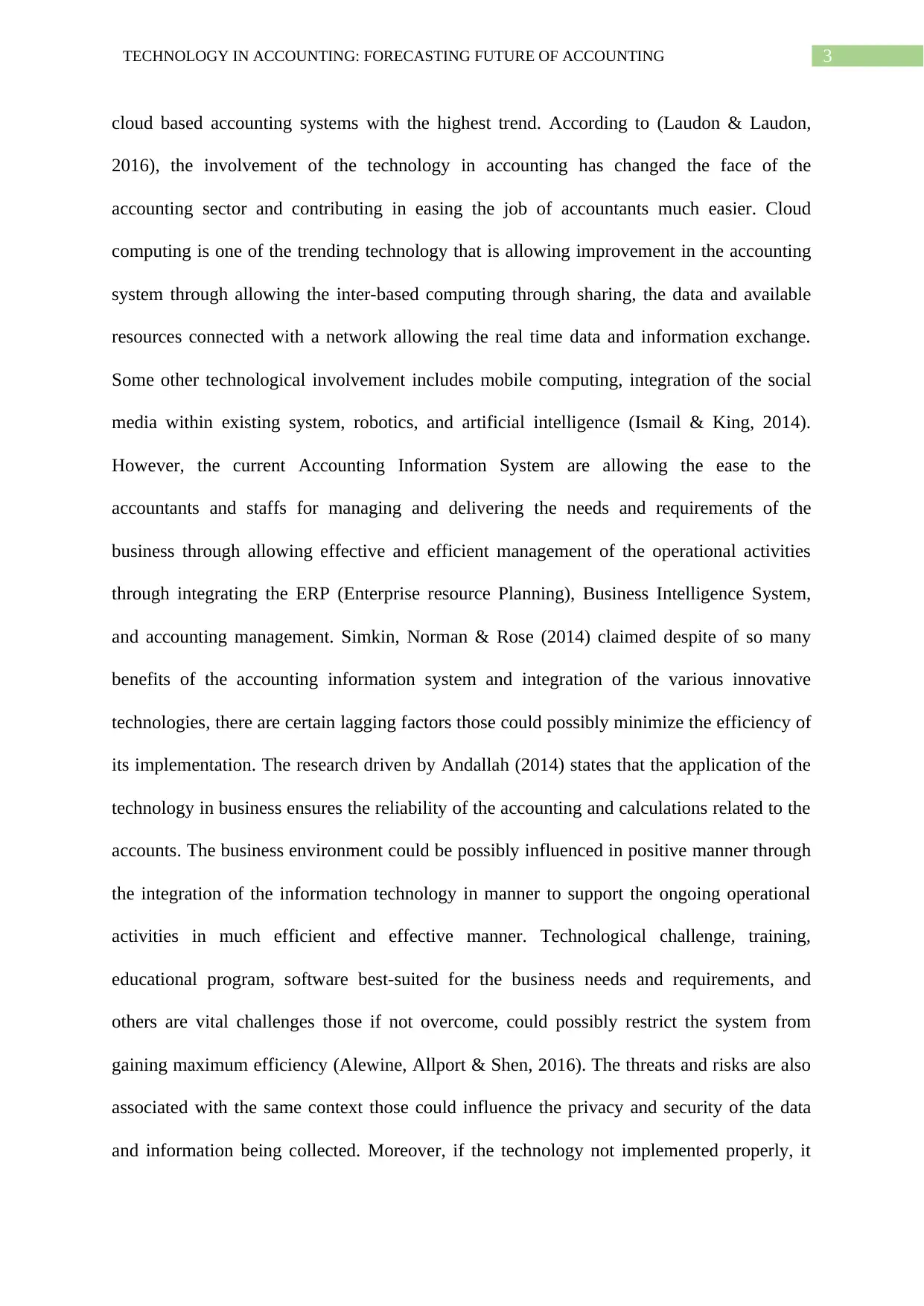
3TECHNOLOGY IN ACCOUNTING: FORECASTING FUTURE OF ACCOUNTING
cloud based accounting systems with the highest trend. According to (Laudon & Laudon,
2016), the involvement of the technology in accounting has changed the face of the
accounting sector and contributing in easing the job of accountants much easier. Cloud
computing is one of the trending technology that is allowing improvement in the accounting
system through allowing the inter-based computing through sharing, the data and available
resources connected with a network allowing the real time data and information exchange.
Some other technological involvement includes mobile computing, integration of the social
media within existing system, robotics, and artificial intelligence (Ismail & King, 2014).
However, the current Accounting Information System are allowing the ease to the
accountants and staffs for managing and delivering the needs and requirements of the
business through allowing effective and efficient management of the operational activities
through integrating the ERP (Enterprise resource Planning), Business Intelligence System,
and accounting management. Simkin, Norman & Rose (2014) claimed despite of so many
benefits of the accounting information system and integration of the various innovative
technologies, there are certain lagging factors those could possibly minimize the efficiency of
its implementation. The research driven by Andallah (2014) states that the application of the
technology in business ensures the reliability of the accounting and calculations related to the
accounts. The business environment could be possibly influenced in positive manner through
the integration of the information technology in manner to support the ongoing operational
activities in much efficient and effective manner. Technological challenge, training,
educational program, software best-suited for the business needs and requirements, and
others are vital challenges those if not overcome, could possibly restrict the system from
gaining maximum efficiency (Alewine, Allport & Shen, 2016). The threats and risks are also
associated with the same context those could influence the privacy and security of the data
and information being collected. Moreover, if the technology not implemented properly, it
cloud based accounting systems with the highest trend. According to (Laudon & Laudon,
2016), the involvement of the technology in accounting has changed the face of the
accounting sector and contributing in easing the job of accountants much easier. Cloud
computing is one of the trending technology that is allowing improvement in the accounting
system through allowing the inter-based computing through sharing, the data and available
resources connected with a network allowing the real time data and information exchange.
Some other technological involvement includes mobile computing, integration of the social
media within existing system, robotics, and artificial intelligence (Ismail & King, 2014).
However, the current Accounting Information System are allowing the ease to the
accountants and staffs for managing and delivering the needs and requirements of the
business through allowing effective and efficient management of the operational activities
through integrating the ERP (Enterprise resource Planning), Business Intelligence System,
and accounting management. Simkin, Norman & Rose (2014) claimed despite of so many
benefits of the accounting information system and integration of the various innovative
technologies, there are certain lagging factors those could possibly minimize the efficiency of
its implementation. The research driven by Andallah (2014) states that the application of the
technology in business ensures the reliability of the accounting and calculations related to the
accounts. The business environment could be possibly influenced in positive manner through
the integration of the information technology in manner to support the ongoing operational
activities in much efficient and effective manner. Technological challenge, training,
educational program, software best-suited for the business needs and requirements, and
others are vital challenges those if not overcome, could possibly restrict the system from
gaining maximum efficiency (Alewine, Allport & Shen, 2016). The threats and risks are also
associated with the same context those could influence the privacy and security of the data
and information being collected. Moreover, if the technology not implemented properly, it
Paraphrase This Document
Need a fresh take? Get an instant paraphrase of this document with our AI Paraphraser
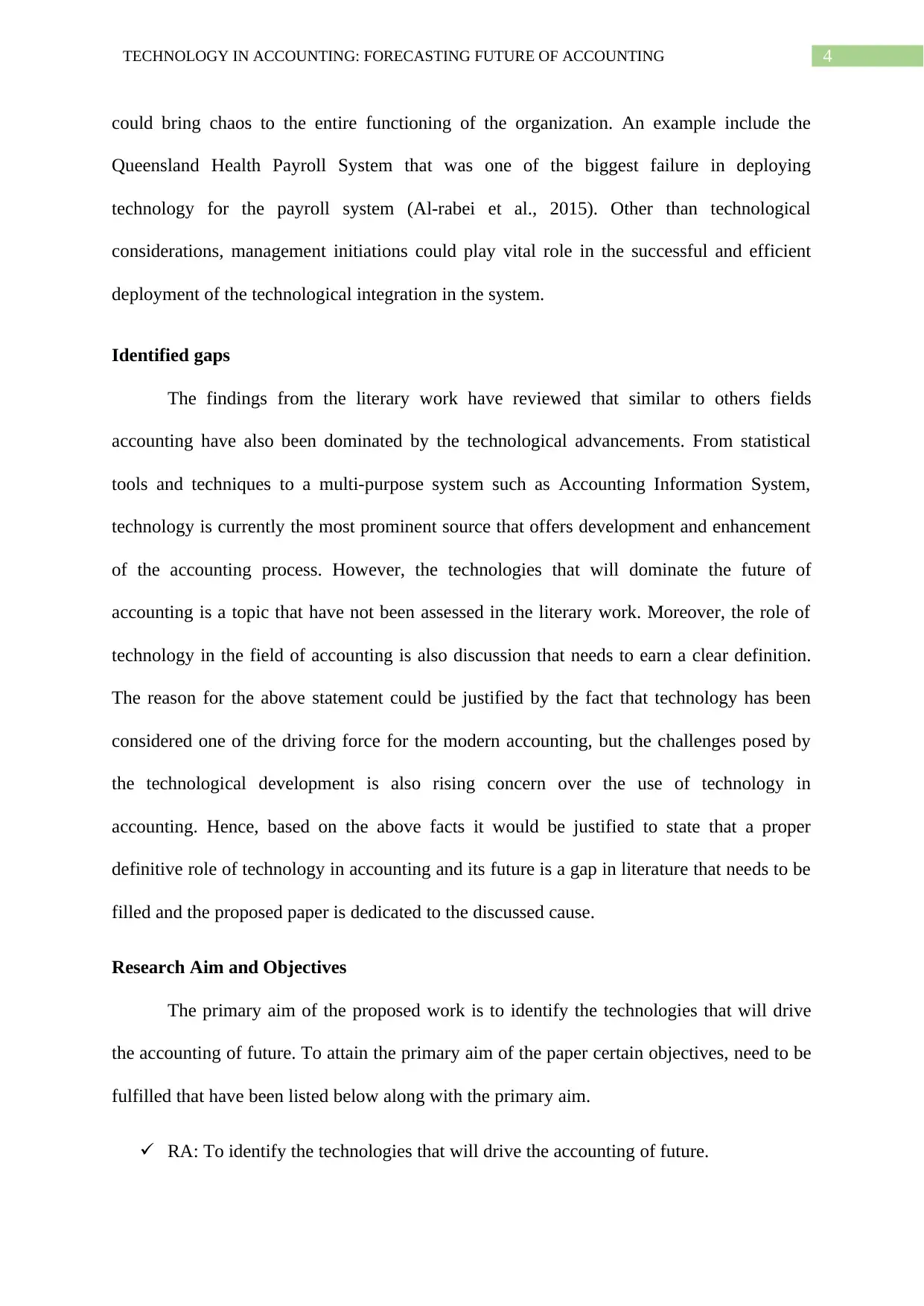
4TECHNOLOGY IN ACCOUNTING: FORECASTING FUTURE OF ACCOUNTING
could bring chaos to the entire functioning of the organization. An example include the
Queensland Health Payroll System that was one of the biggest failure in deploying
technology for the payroll system (Al-rabei et al., 2015). Other than technological
considerations, management initiations could play vital role in the successful and efficient
deployment of the technological integration in the system.
Identified gaps
The findings from the literary work have reviewed that similar to others fields
accounting have also been dominated by the technological advancements. From statistical
tools and techniques to a multi-purpose system such as Accounting Information System,
technology is currently the most prominent source that offers development and enhancement
of the accounting process. However, the technologies that will dominate the future of
accounting is a topic that have not been assessed in the literary work. Moreover, the role of
technology in the field of accounting is also discussion that needs to earn a clear definition.
The reason for the above statement could be justified by the fact that technology has been
considered one of the driving force for the modern accounting, but the challenges posed by
the technological development is also rising concern over the use of technology in
accounting. Hence, based on the above facts it would be justified to state that a proper
definitive role of technology in accounting and its future is a gap in literature that needs to be
filled and the proposed paper is dedicated to the discussed cause.
Research Aim and Objectives
The primary aim of the proposed work is to identify the technologies that will drive
the accounting of future. To attain the primary aim of the paper certain objectives, need to be
fulfilled that have been listed below along with the primary aim.
RA: To identify the technologies that will drive the accounting of future.
could bring chaos to the entire functioning of the organization. An example include the
Queensland Health Payroll System that was one of the biggest failure in deploying
technology for the payroll system (Al-rabei et al., 2015). Other than technological
considerations, management initiations could play vital role in the successful and efficient
deployment of the technological integration in the system.
Identified gaps
The findings from the literary work have reviewed that similar to others fields
accounting have also been dominated by the technological advancements. From statistical
tools and techniques to a multi-purpose system such as Accounting Information System,
technology is currently the most prominent source that offers development and enhancement
of the accounting process. However, the technologies that will dominate the future of
accounting is a topic that have not been assessed in the literary work. Moreover, the role of
technology in the field of accounting is also discussion that needs to earn a clear definition.
The reason for the above statement could be justified by the fact that technology has been
considered one of the driving force for the modern accounting, but the challenges posed by
the technological development is also rising concern over the use of technology in
accounting. Hence, based on the above facts it would be justified to state that a proper
definitive role of technology in accounting and its future is a gap in literature that needs to be
filled and the proposed paper is dedicated to the discussed cause.
Research Aim and Objectives
The primary aim of the proposed work is to identify the technologies that will drive
the accounting of future. To attain the primary aim of the paper certain objectives, need to be
fulfilled that have been listed below along with the primary aim.
RA: To identify the technologies that will drive the accounting of future.
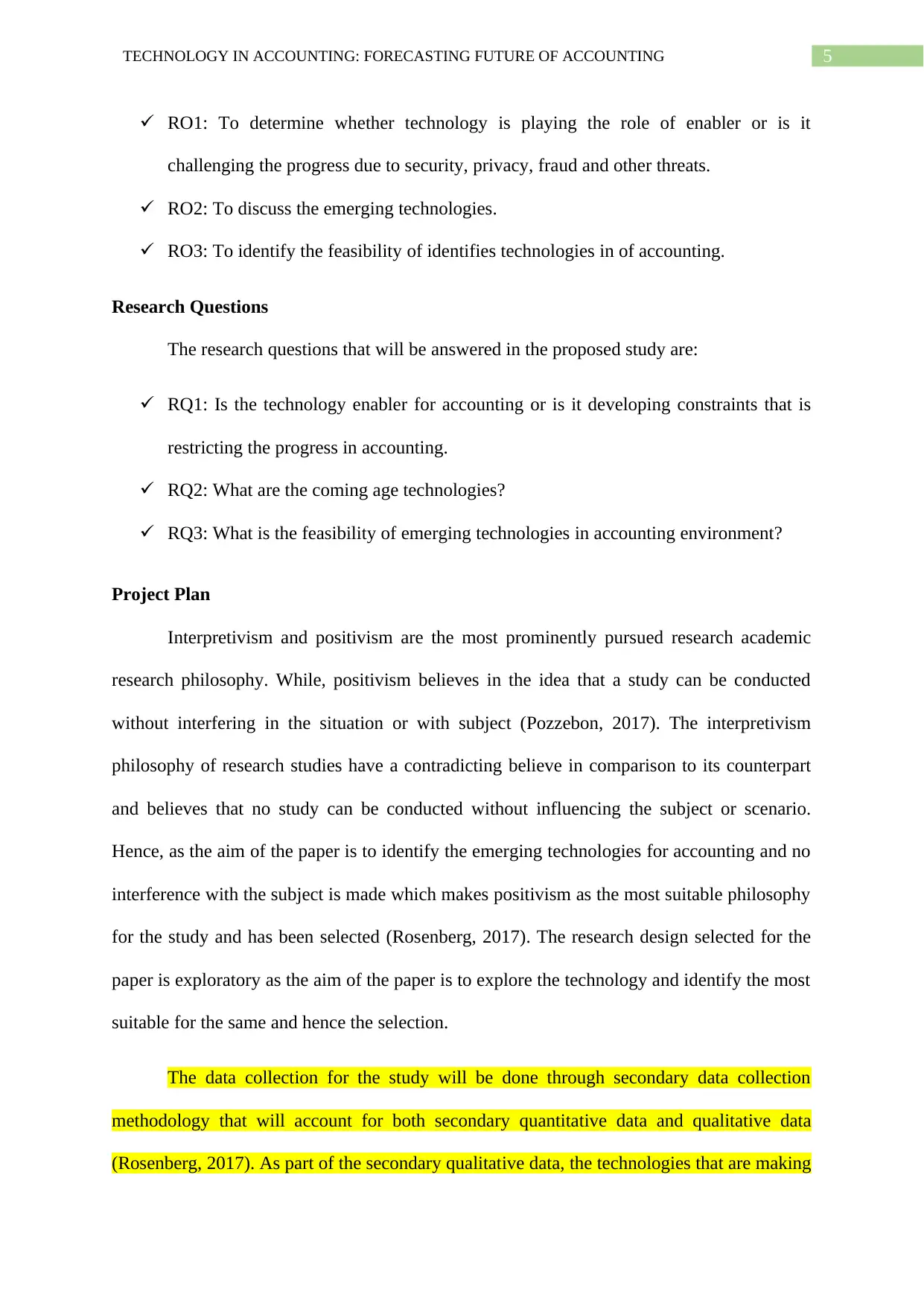
5TECHNOLOGY IN ACCOUNTING: FORECASTING FUTURE OF ACCOUNTING
RO1: To determine whether technology is playing the role of enabler or is it
challenging the progress due to security, privacy, fraud and other threats.
RO2: To discuss the emerging technologies.
RO3: To identify the feasibility of identifies technologies in of accounting.
Research Questions
The research questions that will be answered in the proposed study are:
RQ1: Is the technology enabler for accounting or is it developing constraints that is
restricting the progress in accounting.
RQ2: What are the coming age technologies?
RQ3: What is the feasibility of emerging technologies in accounting environment?
Project Plan
Interpretivism and positivism are the most prominently pursued research academic
research philosophy. While, positivism believes in the idea that a study can be conducted
without interfering in the situation or with subject (Pozzebon, 2017). The interpretivism
philosophy of research studies have a contradicting believe in comparison to its counterpart
and believes that no study can be conducted without influencing the subject or scenario.
Hence, as the aim of the paper is to identify the emerging technologies for accounting and no
interference with the subject is made which makes positivism as the most suitable philosophy
for the study and has been selected (Rosenberg, 2017). The research design selected for the
paper is exploratory as the aim of the paper is to explore the technology and identify the most
suitable for the same and hence the selection.
The data collection for the study will be done through secondary data collection
methodology that will account for both secondary quantitative data and qualitative data
(Rosenberg, 2017). As part of the secondary qualitative data, the technologies that are making
RO1: To determine whether technology is playing the role of enabler or is it
challenging the progress due to security, privacy, fraud and other threats.
RO2: To discuss the emerging technologies.
RO3: To identify the feasibility of identifies technologies in of accounting.
Research Questions
The research questions that will be answered in the proposed study are:
RQ1: Is the technology enabler for accounting or is it developing constraints that is
restricting the progress in accounting.
RQ2: What are the coming age technologies?
RQ3: What is the feasibility of emerging technologies in accounting environment?
Project Plan
Interpretivism and positivism are the most prominently pursued research academic
research philosophy. While, positivism believes in the idea that a study can be conducted
without interfering in the situation or with subject (Pozzebon, 2017). The interpretivism
philosophy of research studies have a contradicting believe in comparison to its counterpart
and believes that no study can be conducted without influencing the subject or scenario.
Hence, as the aim of the paper is to identify the emerging technologies for accounting and no
interference with the subject is made which makes positivism as the most suitable philosophy
for the study and has been selected (Rosenberg, 2017). The research design selected for the
paper is exploratory as the aim of the paper is to explore the technology and identify the most
suitable for the same and hence the selection.
The data collection for the study will be done through secondary data collection
methodology that will account for both secondary quantitative data and qualitative data
(Rosenberg, 2017). As part of the secondary qualitative data, the technologies that are making
⊘ This is a preview!⊘
Do you want full access?
Subscribe today to unlock all pages.

Trusted by 1+ million students worldwide
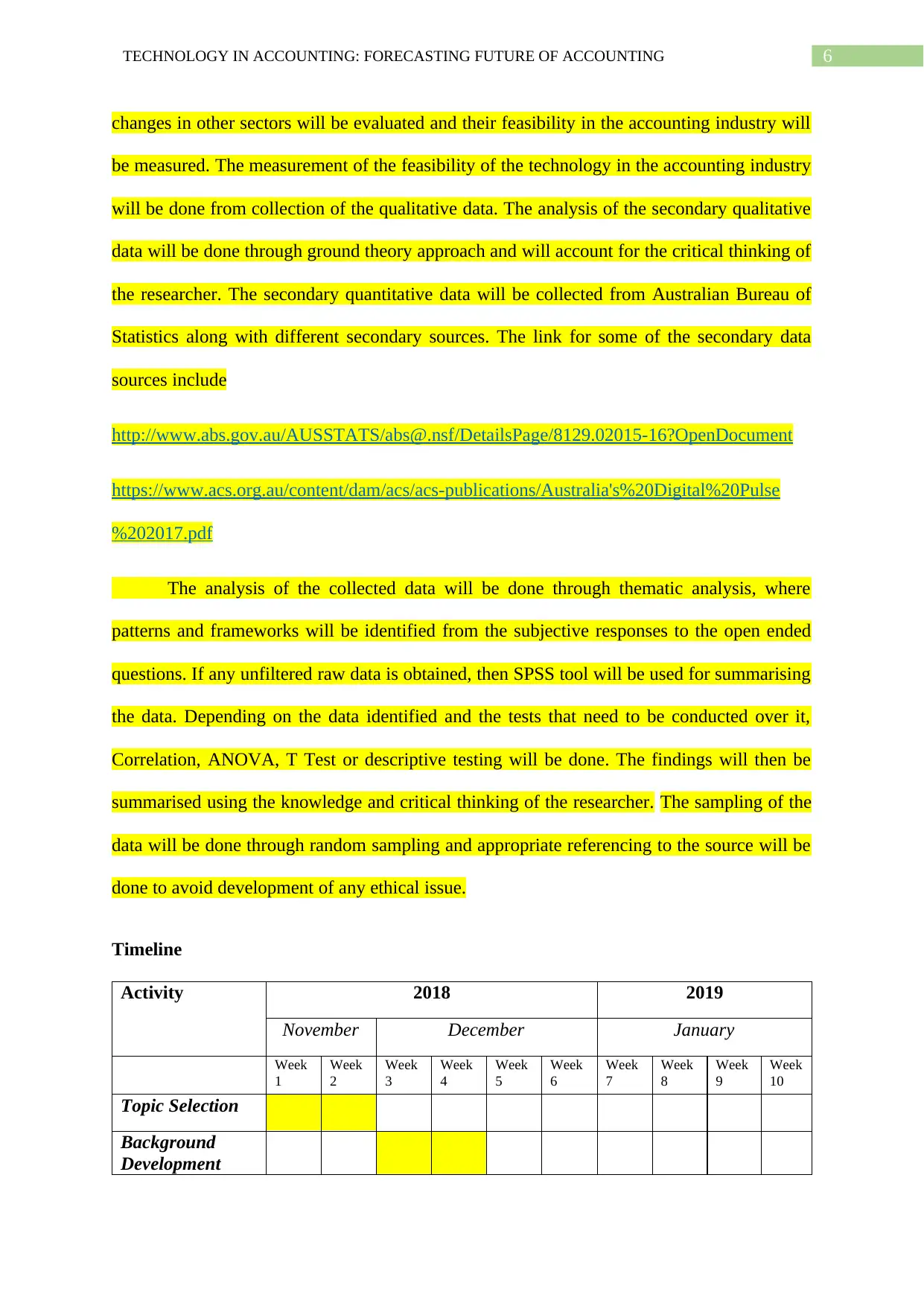
6TECHNOLOGY IN ACCOUNTING: FORECASTING FUTURE OF ACCOUNTING
changes in other sectors will be evaluated and their feasibility in the accounting industry will
be measured. The measurement of the feasibility of the technology in the accounting industry
will be done from collection of the qualitative data. The analysis of the secondary qualitative
data will be done through ground theory approach and will account for the critical thinking of
the researcher. The secondary quantitative data will be collected from Australian Bureau of
Statistics along with different secondary sources. The link for some of the secondary data
sources include
http://www.abs.gov.au/AUSSTATS/abs@.nsf/DetailsPage/8129.02015-16?OpenDocument
https://www.acs.org.au/content/dam/acs/acs-publications/Australia's%20Digital%20Pulse
%202017.pdf
The analysis of the collected data will be done through thematic analysis, where
patterns and frameworks will be identified from the subjective responses to the open ended
questions. If any unfiltered raw data is obtained, then SPSS tool will be used for summarising
the data. Depending on the data identified and the tests that need to be conducted over it,
Correlation, ANOVA, T Test or descriptive testing will be done. The findings will then be
summarised using the knowledge and critical thinking of the researcher. The sampling of the
data will be done through random sampling and appropriate referencing to the source will be
done to avoid development of any ethical issue.
Timeline
Activity 2018 2019
November December January
Week
1
Week
2
Week
3
Week
4
Week
5
Week
6
Week
7
Week
8
Week
9
Week
10
Topic Selection
Background
Development
changes in other sectors will be evaluated and their feasibility in the accounting industry will
be measured. The measurement of the feasibility of the technology in the accounting industry
will be done from collection of the qualitative data. The analysis of the secondary qualitative
data will be done through ground theory approach and will account for the critical thinking of
the researcher. The secondary quantitative data will be collected from Australian Bureau of
Statistics along with different secondary sources. The link for some of the secondary data
sources include
http://www.abs.gov.au/AUSSTATS/abs@.nsf/DetailsPage/8129.02015-16?OpenDocument
https://www.acs.org.au/content/dam/acs/acs-publications/Australia's%20Digital%20Pulse
%202017.pdf
The analysis of the collected data will be done through thematic analysis, where
patterns and frameworks will be identified from the subjective responses to the open ended
questions. If any unfiltered raw data is obtained, then SPSS tool will be used for summarising
the data. Depending on the data identified and the tests that need to be conducted over it,
Correlation, ANOVA, T Test or descriptive testing will be done. The findings will then be
summarised using the knowledge and critical thinking of the researcher. The sampling of the
data will be done through random sampling and appropriate referencing to the source will be
done to avoid development of any ethical issue.
Timeline
Activity 2018 2019
November December January
Week
1
Week
2
Week
3
Week
4
Week
5
Week
6
Week
7
Week
8
Week
9
Week
10
Topic Selection
Background
Development
Paraphrase This Document
Need a fresh take? Get an instant paraphrase of this document with our AI Paraphraser
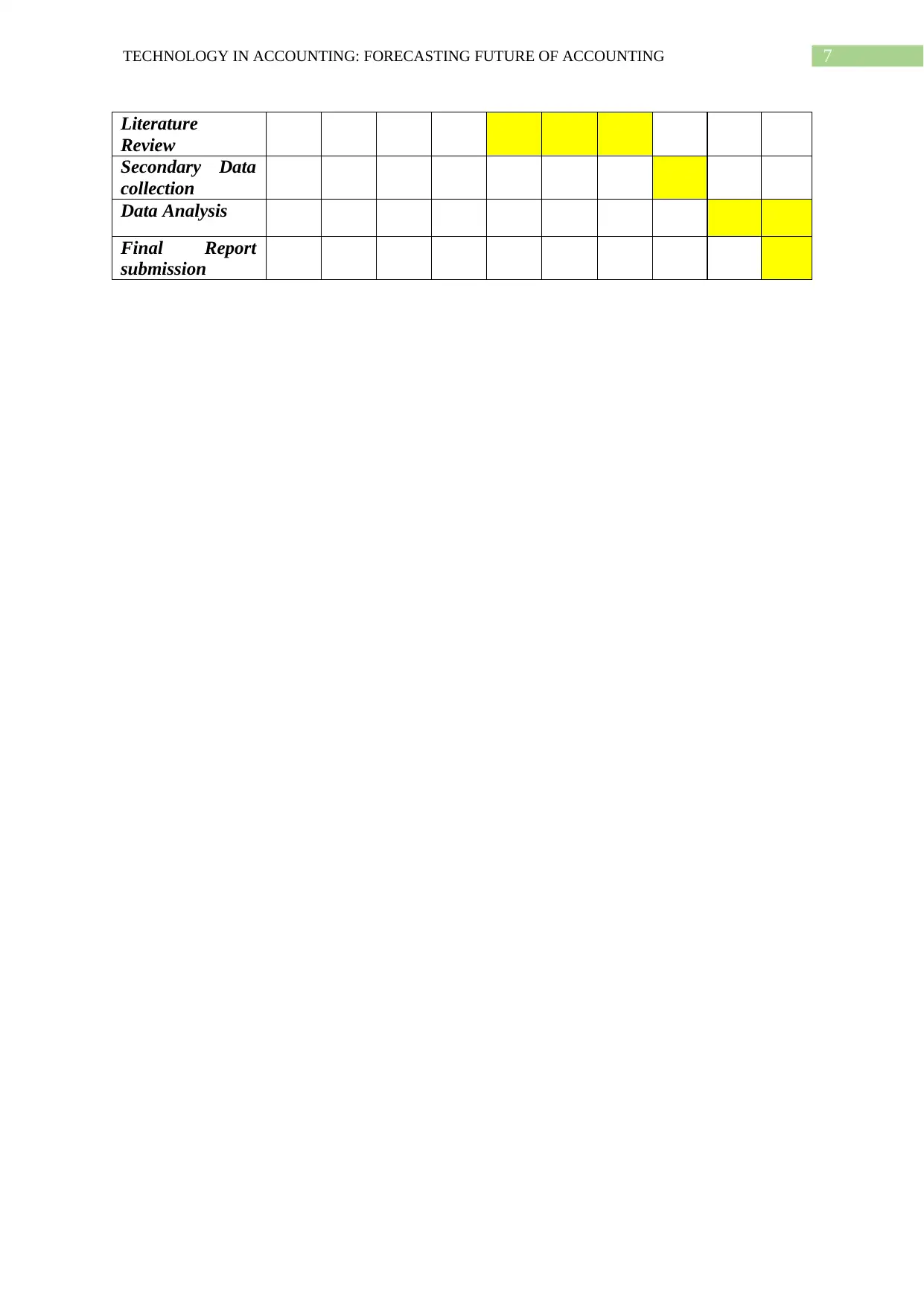
7TECHNOLOGY IN ACCOUNTING: FORECASTING FUTURE OF ACCOUNTING
Literature
Review
Secondary Data
collection
Data Analysis
Final Report
submission
Literature
Review
Secondary Data
collection
Data Analysis
Final Report
submission
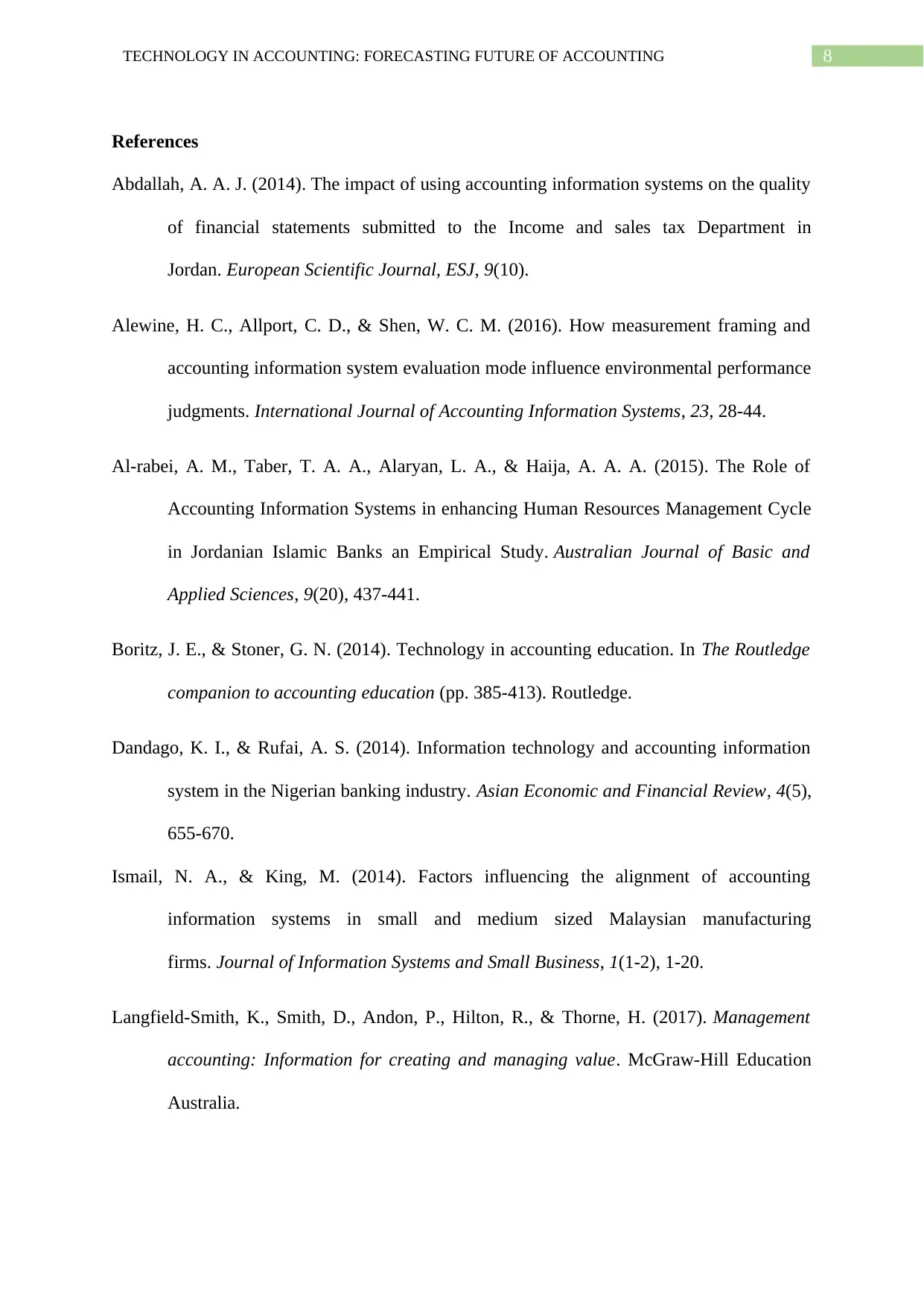
8TECHNOLOGY IN ACCOUNTING: FORECASTING FUTURE OF ACCOUNTING
References
Abdallah, A. A. J. (2014). The impact of using accounting information systems on the quality
of financial statements submitted to the Income and sales tax Department in
Jordan. European Scientific Journal, ESJ, 9(10).
Alewine, H. C., Allport, C. D., & Shen, W. C. M. (2016). How measurement framing and
accounting information system evaluation mode influence environmental performance
judgments. International Journal of Accounting Information Systems, 23, 28-44.
Al-rabei, A. M., Taber, T. A. A., Alaryan, L. A., & Haija, A. A. A. (2015). The Role of
Accounting Information Systems in enhancing Human Resources Management Cycle
in Jordanian Islamic Banks an Empirical Study. Australian Journal of Basic and
Applied Sciences, 9(20), 437-441.
Boritz, J. E., & Stoner, G. N. (2014). Technology in accounting education. In The Routledge
companion to accounting education (pp. 385-413). Routledge.
Dandago, K. I., & Rufai, A. S. (2014). Information technology and accounting information
system in the Nigerian banking industry. Asian Economic and Financial Review, 4(5),
655-670.
Ismail, N. A., & King, M. (2014). Factors influencing the alignment of accounting
information systems in small and medium sized Malaysian manufacturing
firms. Journal of Information Systems and Small Business, 1(1-2), 1-20.
Langfield-Smith, K., Smith, D., Andon, P., Hilton, R., & Thorne, H. (2017). Management
accounting: Information for creating and managing value. McGraw-Hill Education
Australia.
References
Abdallah, A. A. J. (2014). The impact of using accounting information systems on the quality
of financial statements submitted to the Income and sales tax Department in
Jordan. European Scientific Journal, ESJ, 9(10).
Alewine, H. C., Allport, C. D., & Shen, W. C. M. (2016). How measurement framing and
accounting information system evaluation mode influence environmental performance
judgments. International Journal of Accounting Information Systems, 23, 28-44.
Al-rabei, A. M., Taber, T. A. A., Alaryan, L. A., & Haija, A. A. A. (2015). The Role of
Accounting Information Systems in enhancing Human Resources Management Cycle
in Jordanian Islamic Banks an Empirical Study. Australian Journal of Basic and
Applied Sciences, 9(20), 437-441.
Boritz, J. E., & Stoner, G. N. (2014). Technology in accounting education. In The Routledge
companion to accounting education (pp. 385-413). Routledge.
Dandago, K. I., & Rufai, A. S. (2014). Information technology and accounting information
system in the Nigerian banking industry. Asian Economic and Financial Review, 4(5),
655-670.
Ismail, N. A., & King, M. (2014). Factors influencing the alignment of accounting
information systems in small and medium sized Malaysian manufacturing
firms. Journal of Information Systems and Small Business, 1(1-2), 1-20.
Langfield-Smith, K., Smith, D., Andon, P., Hilton, R., & Thorne, H. (2017). Management
accounting: Information for creating and managing value. McGraw-Hill Education
Australia.
⊘ This is a preview!⊘
Do you want full access?
Subscribe today to unlock all pages.

Trusted by 1+ million students worldwide
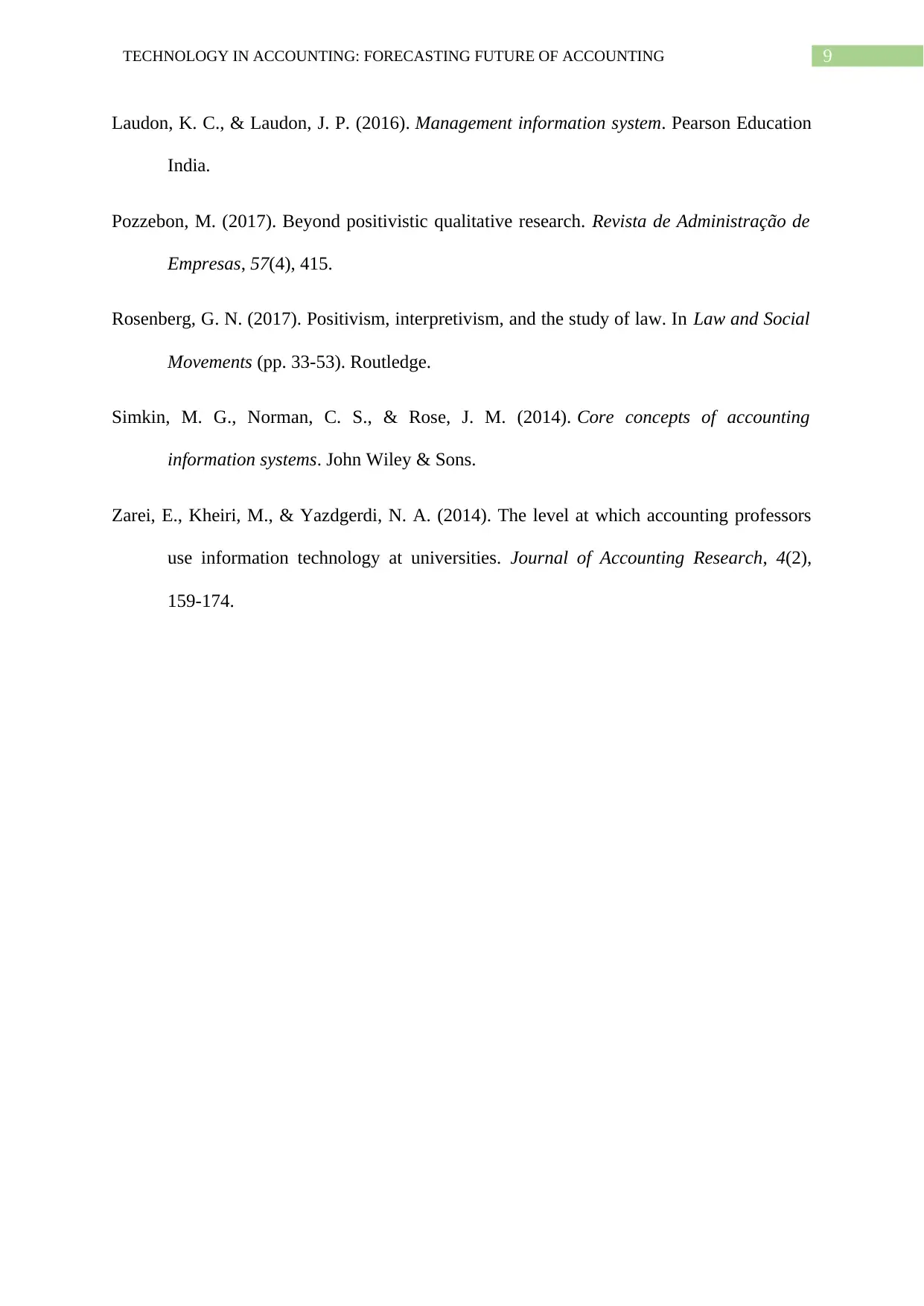
9TECHNOLOGY IN ACCOUNTING: FORECASTING FUTURE OF ACCOUNTING
Laudon, K. C., & Laudon, J. P. (2016). Management information system. Pearson Education
India.
Pozzebon, M. (2017). Beyond positivistic qualitative research. Revista de Administração de
Empresas, 57(4), 415.
Rosenberg, G. N. (2017). Positivism, interpretivism, and the study of law. In Law and Social
Movements (pp. 33-53). Routledge.
Simkin, M. G., Norman, C. S., & Rose, J. M. (2014). Core concepts of accounting
information systems. John Wiley & Sons.
Zarei, E., Kheiri, M., & Yazdgerdi, N. A. (2014). The level at which accounting professors
use information technology at universities. Journal of Accounting Research, 4(2),
159-174.
Laudon, K. C., & Laudon, J. P. (2016). Management information system. Pearson Education
India.
Pozzebon, M. (2017). Beyond positivistic qualitative research. Revista de Administração de
Empresas, 57(4), 415.
Rosenberg, G. N. (2017). Positivism, interpretivism, and the study of law. In Law and Social
Movements (pp. 33-53). Routledge.
Simkin, M. G., Norman, C. S., & Rose, J. M. (2014). Core concepts of accounting
information systems. John Wiley & Sons.
Zarei, E., Kheiri, M., & Yazdgerdi, N. A. (2014). The level at which accounting professors
use information technology at universities. Journal of Accounting Research, 4(2),
159-174.
1 out of 10
Related Documents
Your All-in-One AI-Powered Toolkit for Academic Success.
+13062052269
info@desklib.com
Available 24*7 on WhatsApp / Email
![[object Object]](/_next/static/media/star-bottom.7253800d.svg)
Unlock your academic potential
Copyright © 2020–2025 A2Z Services. All Rights Reserved. Developed and managed by ZUCOL.



